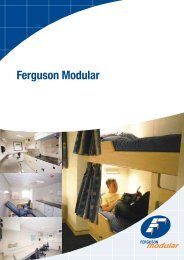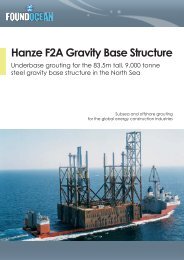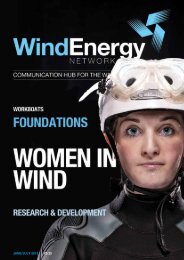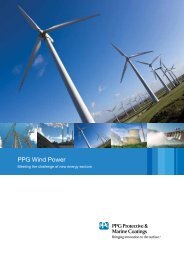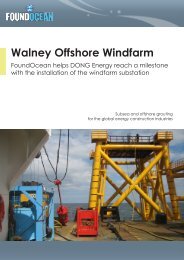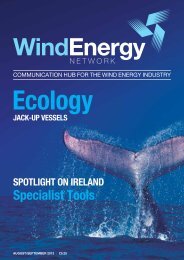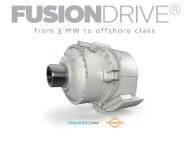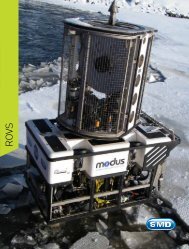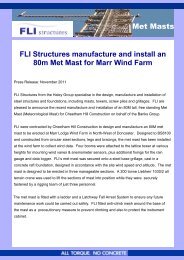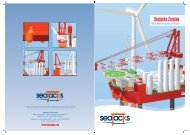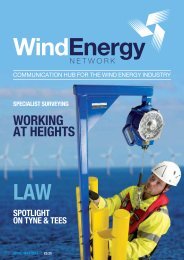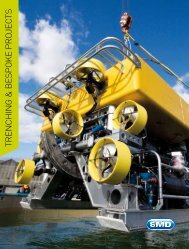Vibration Attenuation & Isolation - Wind Energy Network
Vibration Attenuation & Isolation - Wind Energy Network
Vibration Attenuation & Isolation - Wind Energy Network
- No tags were found...
Create successful ePaper yourself
Turn your PDF publications into a flip-book with our unique Google optimized e-Paper software.
<strong>Vibration</strong> <strong>Attenuation</strong> & <strong>Isolation</strong>• Modelling proves performance of TICO structuralisolation pads in turbine foundation mountingsEuropean <strong>Wind</strong> <strong>Energy</strong> Conference & ExhibitionMarch 2010
Rooftop <strong>Wind</strong> Turbine Installation – Castle CollegeThe ProblemAs part of the redevelopment of the maincampus at Sheffield City College, three 6kWwind turbines were planned for installation ontop of the Castle College building, (seen herein an artist’s impression of the finished site).The top floors of this building house facilitiesand equipment that would be sensitive tovibration. Therefore detailed finite elementcomputer modelling was undertaken in orderto identify the best possible method ofmounting the turbines to the roof to preventvibrations from the turbines being transmittedthrough the structure of the building.The modelling would initially establish the likely vibration frequencies that may betransmitted into the building and then assess the suitability of the chosen antivibrationmaterial in isolating the upper floors of the building from this ‘noise’.Finite Element ModellingThe computer modelling was undertaken by Reactec - experts in the science ofvibration and solution provision for a range of problems where vibration is often thecause – whilst the mounting pad material was recommended and supplied by JamesWalker company Tiflex – specialists in the manufacture of cork-elastomer compositesfor structural foundation and machinery mounting pads.Cont’d
The study would determine whether vibration caused by the wind turbines wouldtransfer into the 7 th floor of the building and breach the 8000 µm/s specified byASHRAE to be adequate for computer equipment, probe test equipment andmicroscopes less that 40x magnification.Worst Case ScenarioThe anti-vibration pad, X-frame support, mast, and turbine installation were evaluatedacross a range of frequencies, the effect of the isolation pads being illustrated bycomparing “isolated” and “non-isolated” frequency response spectra. The isolationsystem tested in the model was a 25mm pad of TICO CV/M placed between the roofmounting plates and the base of the X-frame support.Different wind directions were modelled and results for un-isolated turbines andturbines isolated with TICO CV/M were compared. Several structural resonantfrequencies were identified in the 20 - 25Hz and 45 – 55Hz bands. The excitation ofthese resonances caused significant vibration to travel into the roof mount plates.It was found that under worst case scenario conditions the un-isolated mountingsystem breached the ASHRAE threshold at 51 Hz and 56 Hz, and the overallvibration level in the 0-80 Hz band was 243 µm/s, which also exceeds the ASHRAEthreshold for computer equipment which is 200 µm/s. Mounting the turbines withTICO CV/M moved the discrete breaches at 51 and 56 Hz, and reduced the overallvibration to 145 µm/s.Cont’d
Note to EditorsTiflex is a member of the James Walker Group. This global manufacturinggroup, with an annual turnover in excess of GBP 145-million (euro 160-million),operates through two strategic business units: Sealing Products & Services, andRail Systems & Products. It has 50 production, engineering, distribution andcustomer support sites worldwide and sells in over 100 countries.Further product information available from:Tiflex Limited, Tiflex House, Liskeard, Cornwall, England, PL14 4NBTel: +44 (0)1579 320 808 Fax: + 44 (0)1579 320 802.Email: marketing@tiflex.co.uk Website: www.tiflex.co.ukFurther press information and images available from:Nigel Stansfield, James Walker SPS LtdTel: +44 (0) 7595 202 928 E: nigel.stansfield@jameswalker.biz



